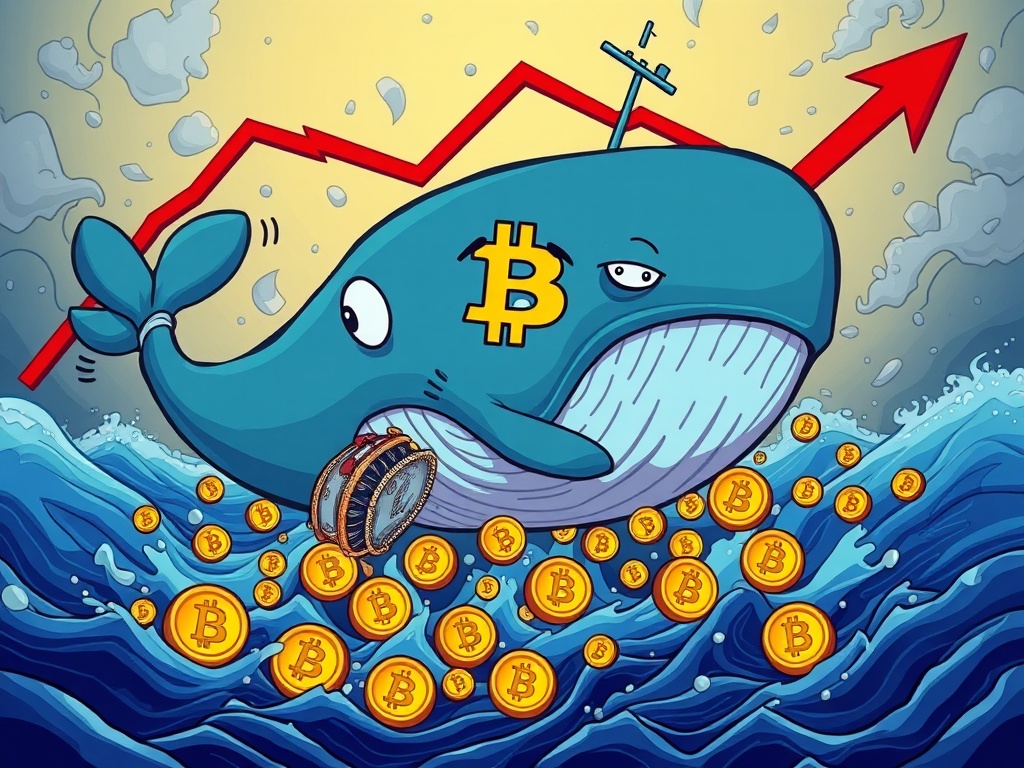BitcoinWorld

Catastrophic Bitcoin Whale Liquidation: $40M Loss Rocks Hyperliquid
The cryptocurrency market, known for its rapid shifts and dramatic turns, recently witnessed a truly catastrophic event that sent ripples through the trading community. As Bitcoin (BTC) experienced a significant downturn, dipping below the $115,000 mark, a prominent trader, widely recognized as a Bitcoin Whale, faced a devastating blow. This incident serves as a stark reminder of the inherent volatility and the high stakes involved in leveraged crypto trading.
The Anatomy of a Catastrophic Bitcoin Whale Liquidation
In the high-octane world of decentralized finance (DeFi), events can unfold with startling speed. The recent liquidation of a prominent Bitcoin Whale on Hyperliquid, a leading decentralized exchange (DEX), is a prime example. The trader, known by the alias Aguila Trades, saw their entire deposited capital wiped out, amounting to a staggering $40 million loss. This dramatic event was quickly highlighted by the on-chain analytics platform Onchain Lens, which tracks significant movements within the blockchain ecosystem.
At the heart of this liquidation was Bitcoin’s sharp price decline. When BTC plummeted below $115,000, it triggered a cascade of events that ultimately led to Aguila Trades’ full liquidation. For a trader of this magnitude, such a loss is not just a personal setback; it sends shockwaves through the market, influencing sentiment and potentially impacting other leveraged positions.
Understanding the Hyperliquid Incident: What Happened to the Bitcoin Whale?
To fully grasp the gravity of this situation, it’s essential to understand the mechanics behind it. Hyperliquid is a decentralized perpetual futures exchange, allowing users to trade with leverage. Leverage amplifies both potential gains and losses, meaning a small price movement can have a disproportionately large impact on a trader’s capital. In this instance, the Bitcoin Whale likely held a highly leveraged long position, betting on Bitcoin’s price to increase.
Here’s a simplified breakdown of what typically occurs in such a scenario:
- Initial Position: The trader opens a leveraged position, depositing a certain amount of collateral (margin).
- Price Movement: Bitcoin’s price begins to fall, moving against the trader’s long position.
- Margin Call/Liquidation Threshold: As the unrealized losses mount, the trader’s margin level drops. If it falls below a certain threshold, the exchange automatically liquidates the position to prevent further losses for the exchange and ensure solvency.
- Full Loss: In the case of Aguila Trades, the speed and magnitude of Bitcoin’s decline meant that the liquidation occurred swiftly, consuming all deposited funds, leaving only a minuscule $86,000 in the wallet.
This incident underscores the double-edged sword of leverage, a tool that can lead to immense profits but also catastrophic losses, especially for a Bitcoin Whale operating with such significant capital.
Why Bitcoin Whale Liquidations Matter for the Market
When a large entity like a Bitcoin Whale gets liquidated, it’s not just an isolated event; it has broader implications for the entire crypto market. Here’s why:
- Market Contagion: Large liquidations can sometimes trigger further selling pressure. The automated selling of a liquidated position adds to the supply, potentially driving prices down further and leading to more liquidations in a chain reaction.
- Sentiment Shift: Such high-profile losses can dampen market sentiment, making other traders more cautious and less willing to take on risk. This can lead to decreased trading volume and a general slowdown.
- Volatility Spike: Liquidations often occur during periods of high volatility and can, in turn, contribute to even greater price swings as large positions are unwound.
- DeFi Ecosystem Health: For decentralized exchanges like Hyperliquid, while liquidations are a necessary mechanism to maintain platform stability, frequent large-scale events can raise questions about the robustness of their liquidation engines under extreme stress.
The incident involving this particular Bitcoin Whale serves as a cautionary tale, highlighting the systemic risks that can arise from highly concentrated leveraged positions.
Navigating Volatility: Lessons from the Bitcoin Whale’s Plight
The dramatic loss experienced by Aguila Trades offers invaluable lessons for all participants in the crypto market, from novice traders to seasoned investors and even other aspiring Bitcoin Whales. Understanding these lessons can help mitigate risks and foster more sustainable trading practices.
The Perils of Excessive Leverage
Leverage is a powerful tool, but it demands respect. While it can magnify returns on correct predictions, it equally amplifies losses when the market moves against a position. The higher the leverage, the smaller the price movement required to trigger a liquidation. This incident is a stark reminder that even sophisticated traders can be caught off guard by rapid market shifts.
The Importance of Risk Management
Effective risk management is paramount. This includes:
- Setting Stop-Loss Orders: Automatically closing a position if it reaches a predetermined loss level can prevent total capital wipeout.
- Appropriate Position Sizing: Never allocate more capital to a single trade than you can afford to lose.
- Diversification: Spreading investments across different assets can reduce the impact of a single asset’s poor performance.
- Monitoring Market Conditions: Staying informed about macroeconomic factors, market sentiment, and on-chain data can provide crucial insights.
Decentralized Exchanges and Their Unique Risks
While DEXs offer advantages like self-custody and censorship resistance, they also come with their own set of risks:
| Feature | Centralized Exchange (CEX) | Decentralized Exchange (DEX) |
|---|---|---|
| Custody | Exchange holds funds | User holds funds (self-custody) |
| KYC/AML | Required | Generally not required |
| Liquidity | Often higher | Varies, can be lower for niche pairs |
| Security Risks | Exchange hacks, single point of failure | Smart contract bugs, front-running |
| Liquidation Process | Managed by exchange backend | Automated by smart contracts |
Hyperliquid, being a DEX, relies on smart contracts for its operations, including liquidations. While efficient, this automation means less human intervention and often faster, unforgiving execution during volatile periods. This is a critical factor for any Bitcoin Whale or large trader to consider.
Protecting Your Portfolio: Actionable Insights for Bitcoin Traders
For those looking to navigate the treacherous waters of crypto trading, particularly with an asset as volatile as Bitcoin, here are some actionable insights:
- Educate Yourself: Understand the mechanisms of leveraged trading, perpetual futures, and the specific risks associated with the platforms you use.
- Start Small: If experimenting with leverage, begin with very small amounts of capital to learn the ropes without risking significant funds.
- Never FOMO: Fear of Missing Out (FOMO) often leads to irrational decisions and overleveraging. Stick to your trading plan.
- Stay Updated: Keep an eye on market news, technical analysis, and on-chain metrics that can signal potential shifts in Bitcoin’s price action.
- Consider Hedging Strategies: Advanced traders might explore hedging techniques to offset potential losses in their primary positions.
The story of this liquidated Bitcoin Whale is a powerful reminder that even the biggest players are subject to market forces. Prudence, knowledge, and disciplined risk management are the best defenses against such dramatic losses.
Conclusion: A Wake-Up Call for the Crypto Community
The $40 million liquidation of the Bitcoin Whale, Aguila Trades, on Hyperliquid is more than just a headline; it’s a profound illustration of the extreme risks and rewards inherent in the cryptocurrency market. It underscores the critical importance of robust risk management, particularly when engaging in leveraged trading on decentralized platforms. While the allure of amplified gains is strong, the potential for catastrophic losses is equally real. This event serves as a stark wake-up call, urging all traders to approach the market with caution, informed strategies, and a deep understanding of the tools they employ. Ultimately, safeguarding capital and ensuring long-term participation in this dynamic space hinges on learning from such dramatic incidents and adapting one’s approach accordingly.
Frequently Asked Questions (FAQs)
Q1: What is a Bitcoin Whale?
A Bitcoin Whale refers to an individual or entity that holds a very large amount of Bitcoin. Their trading activities, especially large buys or sells, can significantly influence market prices due to the sheer volume of their holdings. They are often seen as major players in the crypto ecosystem.
Q2: What does ‘liquidation’ mean in crypto trading?
In crypto trading, liquidation occurs when a trader’s leveraged position is automatically closed by the exchange. This happens when the value of their collateral (margin) falls below a certain threshold, usually due to adverse price movements. The exchange liquidates the position to prevent the trader’s balance from going negative and to maintain the platform’s solvency.
Q3: What is Hyperliquid?
Hyperliquid is a decentralized exchange (DEX) that specializes in perpetual futures trading. Unlike centralized exchanges, Hyperliquid operates on a blockchain, allowing users to trade directly from their non-custodial wallets. This offers benefits like self-custody of funds and censorship resistance, but also requires users to manage their own private keys and understand smart contract risks.
Q4: How does Bitcoin’s price drop affect leveraged positions?
When Bitcoin’s price drops, it directly impacts leveraged long positions (bets that the price will go up). As the price falls, the unrealized loss on these positions increases. If the loss becomes too large relative to the collateral provided, it can trigger a margin call or automatic liquidation, leading to the loss of the initial investment and potentially more, depending on the leverage used.
Q5: Can I prevent liquidation when trading with leverage?
While you can’t guarantee against all liquidations in highly volatile markets, you can significantly reduce the risk. Key strategies include using lower leverage, setting stop-loss orders, maintaining sufficient margin in your account, and employing sound risk management principles. Regularly monitoring your positions and market conditions is also crucial.
To learn more about the latest crypto market trends, explore our article on key developments shaping Bitcoin price action.
Did you find this article insightful? Share it with your friends and fellow crypto enthusiasts on social media to spread awareness about the critical importance of risk management in the volatile world of cryptocurrency trading!
This post Catastrophic Bitcoin Whale Liquidation: $40M Loss Rocks Hyperliquid first appeared on BitcoinWorld and is written by Editorial Team





